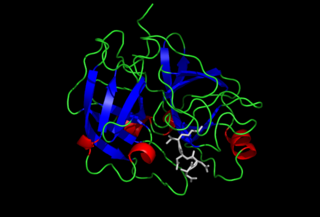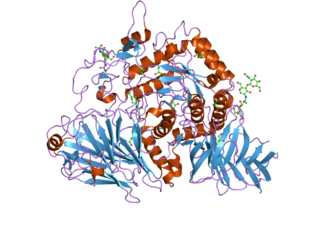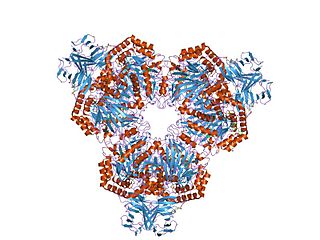Related Research Articles
Sucrase is a digestive enzyme that catalyzes the hydrolysis of sucrose to its subunits fructose and glucose. One form, sucrase-isomaltase, is secreted in the small intestine on the brush border. The sucrase enzyme invertase, which occurs more commonly in plants, also hydrolyzes sucrose but by a different mechanism.

Enteropeptidase is an enzyme produced by cells of the duodenum and is involved in digestion in humans and other animals. Enteropeptidase converts trypsinogen into its active form trypsin, resulting in the subsequent activation of pancreatic digestive enzymes. Absence of enteropeptidase results in intestinal digestion impairment.
Isomaltase is an enzyme that breaks the bonds linking saccharides, which cannot be broken by amylase or maltase. It digests polysaccharides at the alpha 1-6 linkages. Its substrate, alpha-limit dextrin, is a product of amylopectin digestion that retains its 1-6 linkage. The product of the enzymatic digestion of alpha-limit dextrin by isomaltase is maltose.

Beta-hexosaminidase subunit beta is an enzyme that in humans is encoded by the HEXB gene.

Alpha-glucosidase is a glucosidase located in the brush border of the small intestine that acts upon α(1→4) bonds. This is in contrast to beta-glucosidase. Alpha-glucosidase breaks down starch and disaccharides to glucose. Maltase, a similar enzyme that cleaves maltose, is nearly functionally equivalent.

Cholesterol side-chain cleavage enzyme is commonly referred to as P450scc, where "scc" is an acronym for side-chain cleavage. P450scc is a mitochondrial enzyme that catalyzes conversion of cholesterol to pregnenolone. This is the first reaction in the process of steroidogenesis in all mammalian tissues that specialize in the production of various steroid hormones.

Sucrose intolerance or genetic sucrase-isomaltase deficiency (GSID) is the condition in which sucrase-isomaltase, an enzyme needed for proper metabolism of sucrose (sugar) and starch, is not produced or the enzyme produced is either partially functional or non-functional in the small intestine. All GSID patients lack fully functional sucrase, while the isomaltase activity can vary from minimal functionality to almost normal activity. The presence of residual isomaltase activity may explain why some GSID patients are better able to tolerate starch in their diet than others with GSID.

Sucrase-isomaltase (SI) is a glucosidase enzyme located on the brush border of the small intestine. It is a dual-function enzyme with two GH31 domains, one serving as the isomaltase, the other as a sucrose alpha-glucosidase. It has preferential expression in the apical membranes of enterocytes. The enzyme’s purpose is to digest dietary carbohydrates such as starch, sucrose and isomaltose. By further processing the broken-down products, energy in the form of ATP can be generated.
Glucan 1,4-alpha-glucosidase is an enzyme located on the brush border of the small intestine with systematic name 4-alpha-D-glucan glucohydrolase. This enzyme catalyses the following chemical reaction
N-acetyllactosamine synthase is a galactosyltransferase enzyme. It is a component of lactose synthase This enzyme modifies the connection between two molecule UDP-galactose and N-actyl-D-glucosamine and generates two different molecules UDP and N-acetyllactosamine as products. The main function of the enzyme is associated with the biosynthesis of glycoproteins and glycolipids in both human and animals. In human, the activity of this enzyme can be found in Golgi apparatus.

Maltase-glucoamylase, intestinal is an enzyme that in humans is encoded by the MGAM gene.

In molecular biology, glycoside hydrolase family 31 is a family of glycoside hydrolases.

NADH dehydrogenase is an enzyme that converts nicotinamide adenine dinucleotide (NAD) from its reduced form (NADH) to its oxidized form (NAD+). Members of the NADH dehydrogenase family and analogues are commonly systematically named using the format NADH:acceptor oxidoreductase. The chemical reaction these enzymes catalyze are generally represented with the follow equation;

Glucan 1,3-beta-glucosidase is an enzyme with systematic name 3-beta-D-glucan glucohydrolase. This enzyme catalyses the following chemical reaction
Glucan 1,3-alpha-glucosidase is an enzyme with systematic name 3-alpha-D-glucan 3-glucohydrolase. This enzyme catalyses the following chemical reaction
3alpha(S)-strictosidine beta-glucosidase (EC 3.2.1.105) is an enzyme with systematic name strictosidine beta-D-glucohydrolase. This enzyme catalyses the following chemical reaction
Aminopeptidase I is an enzyme. This enzyme catalyses the following chemical reaction
Lysyl endopeptidase is an enzyme. This enzyme catalyses the following chemical reaction
Exo-(1->4)-alpha-D-glucan lyase is an enzyme with systematic name (1->4)-alpha-D-glucan exo-4-lyase (1,5-anhydro-D-fructose-forming). This enzyme catalyses the following chemical reaction
In enzymology, a prostaglandin-F synthase (PGFS; EC 1.1.1.188) is an enzyme that catalyzes the chemical reaction:
References
- ↑ Conklin KA, Yamashiro KM, Gray GM (August 1975). "Human intestinal sucrase-isomaltase. Identification of free sucrase and isomaltase and cleavage of the hybrid into active distinct subunits". The Journal of Biological Chemistry. 250 (15): 5735–41. doi: 10.1016/S0021-9258(19)41116-2 . PMID 807575.
- ↑ Hauri HP, Quaroni A, Isselbacher KJ (October 1979). "Biogenesis of intestinal plasma membrane: posttranslational route and cleavage of sucrase-isomaltase". Proceedings of the National Academy of Sciences of the United States of America. 76 (10): 5183–6. doi: 10.1073/pnas.76.10.5183 . PMC 413104 . PMID 291933.
- ↑ Kolínská J, Kraml J (September 1972). "Separation and characterization of sucrose-isomaltase and of glucoamylase of rat intestine". Biochimica et Biophysica Acta (BBA) - Enzymology. 284 (1): 235–47. doi:10.1016/0005-2744(72)90062-9. PMID 5073761.
- ↑ Sigrist H, Ronner P, Semenza G (October 1975). "A hydrophobic form of the small-intestinal sucrase-isomaltase complex". Biochimica et Biophysica Acta (BBA) - Biomembranes. 406 (3): 433–46. doi:10.1016/0005-2736(75)90022-x. PMID 1182172.
- ↑ Sjöström H, Norén O, Christiansen L, Wacker H, Semenza G (December 1980). "A fully active, two-active-site, single-chain sucrase.isomaltase from pig small intestine. Implications for the biosynthesis of a mammalian integral stalked membrane protein". The Journal of Biological Chemistry. 255 (23): 11332–8. doi: 10.1016/S0021-9258(19)70296-8 . PMID 7002920.
- ↑ Takesue Y (April 1969). "Purification and properties of rabbit intestinal sucrase". Journal of Biochemistry. 65 (4): 545–52. doi:10.1093/oxfordjournals.jbchem.a129048. PMID 5804876.